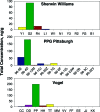Inadvertent polychlorinated biphenyls in commercial paint pigments
- PMID: 19957996
- PMCID: PMC2853905
- DOI: 10.1021/es902413k
Inadvertent polychlorinated biphenyls in commercial paint pigments
Abstract
A polychlorinated biphenyl (PCB) that was not produced as part of the Aroclor mixtures banned in the 1980s was recently reported in air samples collected in Chicago, Philadelphia, the Arctic, and several sites around the Great Lakes. In Chicago, the congener 3,3'-dichlorobiphenyl or PCB11 was found to be the fifth most concentrated congener and ubiquitous throughout the city. The congener exhibited strong seasonal concentration trends that suggest volatilization of this compound from common outdoor surfaces. Due to these findings and also the compound's presence in waters that received waste from paint manufacturing facilities, we hypothesized that PCB11 may be present in current commercial paint. In this study we measured PCBs in paint sold on the current retail market. We tested 33 commercial paint pigments purchased from three local paint stores. The pigment samples were analyzed for all 209 PCB congeners using gas chromatography with tandem mass spectrometry (GC-MS/MS). More than 50 PCB congeners including several dioxin-like PCBs were detected, and the PCB profiles varied due to different types of pigments and different manufacturing processes. PCB congeners were detected in azo and phthalocyanine pigments which are commonly used in paint but also in inks, textiles, paper, cosmetics, leather, plastics, food and other materials. Our findings suggest several possible mechanisms for the inadvertent production of specific PCB congeners during the manufacturing of paint pigments.
Figures




References
-
- Aroclor advertisement by Monsanto Chemical Company. <inline-formula>Chem. Eng.</inline-formula> June1956, p 386.
-
- De Voogt P.; Brinkman U. A. T.. Production, properties and usage of polychlorinated biphenyls. In Halogenated Biphenyls, Terphenyls, Naphthalenes, Dibenzodioxins, and Related Products, 2nd ed.; Kimbrough R. D., Jensen A. A., Eds.; Elsevier Science Ltd: New York, 1989; pp 3−45.
-
-
EPA. Use Authorization for and Distribution in Commerce of Non-Liquid Polychlorinated Biphenyls. Fed. Regist., Vol. 64, No. 237, 1999
-
-
- Choi S. D.; Baek S. Y.; Chang Y. S.; Wania F.; Ikonomou M. G.; Yoon Y. J.; Park B. K.; Hong S. Passive air sampling of polychlorinated biphenyls and organochlorine pesticides at the Korean Arctic and Antarctic research stations: Implications for long-range transport and local pollution. Environ. Sci. Technol. 2008, 42, 7125–7131. - PubMed
Publication types
MeSH terms
Substances
Grants and funding
LinkOut - more resources
Full Text Sources
Molecular Biology Databases
Miscellaneous

